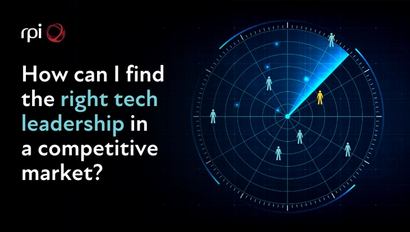Company leadership used to be the trio of Chief Executive Officer, Chief Financial Officer, and Chief Operations Officer. Yet even before the world of work was turned on its head, companies had largely abandoned that minimalist model. In 2019, 82% of CEOs said they’d added to the C-suite in the five years prior. The top three roles created were Chief Innovation Officer, Chief Digital Officer, and Chief Strategy Officer.
In that same survey, well over half of boards, investors, and CEOs considered digital transformation to be a key capability of the C-suite in 5-10 years.
Technology and development are changing the complexion of the C-suite, and the question for businesses is, ‘What should our C-suite look like?’
How technology is changing the C-suite
The remits of traditional-suite roles have always been particular to the people occupying them and the companies they work for. Nothing has ever been completely standardised in terms of how any given C-level executive’s day would look – there would be no competitive advantage if every CEO followed the same course. However, the roles of CEO, COO, or CFO are probably a lot more similar from company to company than that of, say, the Chief Digital Officer.
That’s partly to do with the youth of such titles, but it’s also largely because ‘digital’ is such a broad umbrella in the technology age. It’s woven into every aspect of a business, underpinning almost every function: from internal operations to customer experience.
With newer, technology-linked C-suite roles, different businesses might well describe the same job with a different title. One company’s Chief Digital Officer is another’s Chief Technology Officer, while two Chief Data Officers may have a very different remit and perspective. When a job title could mean one of many things, finding the people with the right experience for your specific objective becomes far more complex than simply searching for someone with previous CTO experience.
With the increase in C-level job titles – and so much variation within each of those titles – how do you successfully extend your C-suite to meet your business goals? Who and what does your business need to drive it forward into a successful digital future?
Growing (and maintaining) your C-suite
Before you extend your c-suite, there are some questions you need to answer internally. They may sound obvious, but they’re easy to overlook.
What are your goals or targets as a business?
What are the internal reasons that you might not meet those goals or targets?
How would you fix those gaps with new skills and direction at the very top?
As C-suites expand in companies around the world, it’s understandable to want to follow suit, but you need to be sure that you’re responding to an actual business need, not hiring a certain Chief just because that’s what competitors are doing. An existing CTO, for instance, may already be successfully driving data-driven initiatives – potentially rendering an incoming Chief Data Officer useless (or worse, unnecessarily disruptive).
While being mindful of those caveats above, let’s discuss some of the tech C-suite roles you might need.
Chief Information Officer
CIO used to be a highly technical role, which has become by and large more strategic as computer and mobile technology has advanced.
The key strength of a successful CIO today is to understand technology in a commercial context. They will understand the lay of the technological land, but also have a sense of its trajectory. What that means for a business is that your CIO will think constantly about trends and developments, and the opportunities those present.
The CIO will likely be the driver of the company’s technology strategies, and will also play a vital role in streamlining and integrating transformation.
Chief Data Officer
Since we live in the data age, the CDO is stewardof arguably the most precious commodity of our era.The four aspects of data that the CDO would tend to handle are Governance, Operations, Innovation, andAnalytics.
The impact of those areas is vast. Data plays an enormous part in business’ daily operations, and the CDO should essentially guide the way that businesses use that data: from ensuring that data quality is maintained, to suggesting new ways to extract commercial value from data.
Legislation like GDPR has raised the stakes enormously when it comes to data, and further data legislations will only heighten the need for firm data leadership at the very top. The legal and commercial consequences of poor data security today are dire, and the larger the company, the greater the exposure. A Chief Data Officer could oversee the necessary protection from cyber-attack and data breach, but for many businesses, this threat has become so severe and so wide-reaching that this remit now falls under its own C-level position: Chief Security Officer.
Chief Information Security Officer
The more digital touch points in a business, the greater their risk of exposure to cyber-crime. A Chief Security Officer can sit alongside other technological C-suite roles to ensure that every innovation is underpinned by stringent cyber security measures.
A CISO can be a valuable asset for businesses looking to scale their digital transformation quickly, enabling them to mitigate cyber risks at every step of the journey while maintaining their flexibility. They also play an important role in educating the business on cyber dangers, with a ‘top down’ approach to cyber security relaying its importance to the business as a whole, and guiding a strong, cohesive cyber security strategy.
Chief Digital Officer
The line between Chief Digital Officer and Chief Information Officer has blurred in recent years, but there are some common distinctions. Some companies might view the CDO as more marketing-focused, with an eye on social media and online communities. That said, a PWC study in 2018 discovered that among chief digital officers, those with a background in marketing had dropped to 18%, from 39% in 2016. CDOs with a tech background, meanwhile, counted for 41%, when two years prior it had only been 32%.
Alternatively, a CDO might be more internally-focused, overseeing the company’s digital culture and technology platforms. Here, you start to see some of the variation between roles discussed earlier, and the complications that can arise when it comes to hiring. When sourcing talent for emerging titles that might mean different things to different businesses, it’s very easy to engage the wrong strengths or set of skills if you search based on job title alone.
Hiring business leaders
The skill that all of the above need to possess, like any C-level executive, is leadership. That’s a skill that’s rare enough in itself, let alone combined with strong technology experience or data governance.
Nonetheless, a chief has to inspire, coordinate, delegate, strategise and envision. If they can’t, no amount of technical, digital, or data expertise will make them succeed. Finding candidates that combine both the technology and leadership talent needed to steer each aspect of a business’ transformation strategy often requires a more global, cross-sector approach: looking for the right individual, with the right approach and skills, to fulfill the right objectives.
RPI’s deep and extensive candidate network – as well our in-depth understanding of digital and technology transformation – makes us the ideal partner for the transformation of your business. If you’re searching for the tech talent to fill your C-suite, get in touch today.



